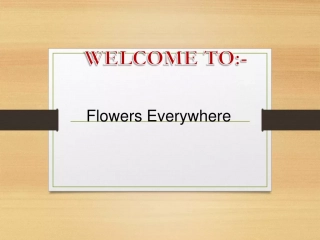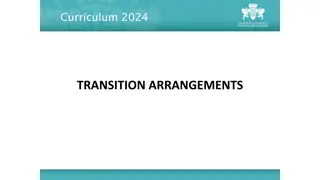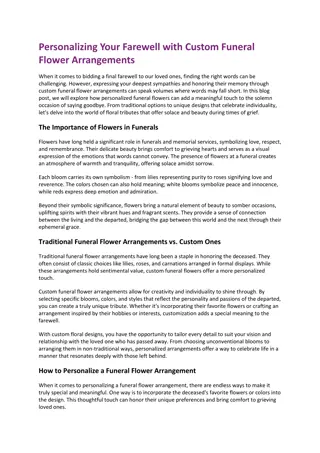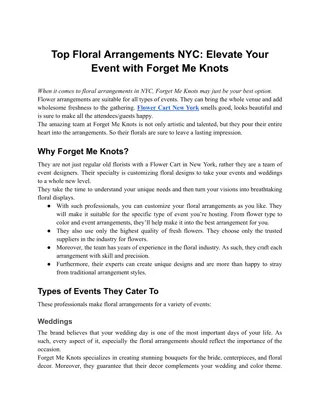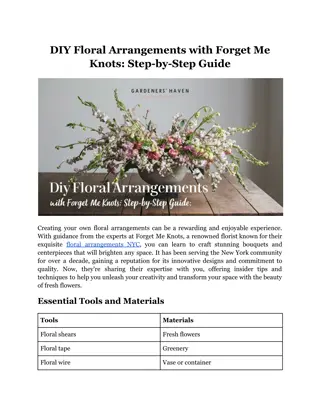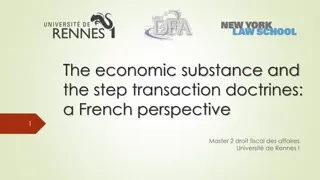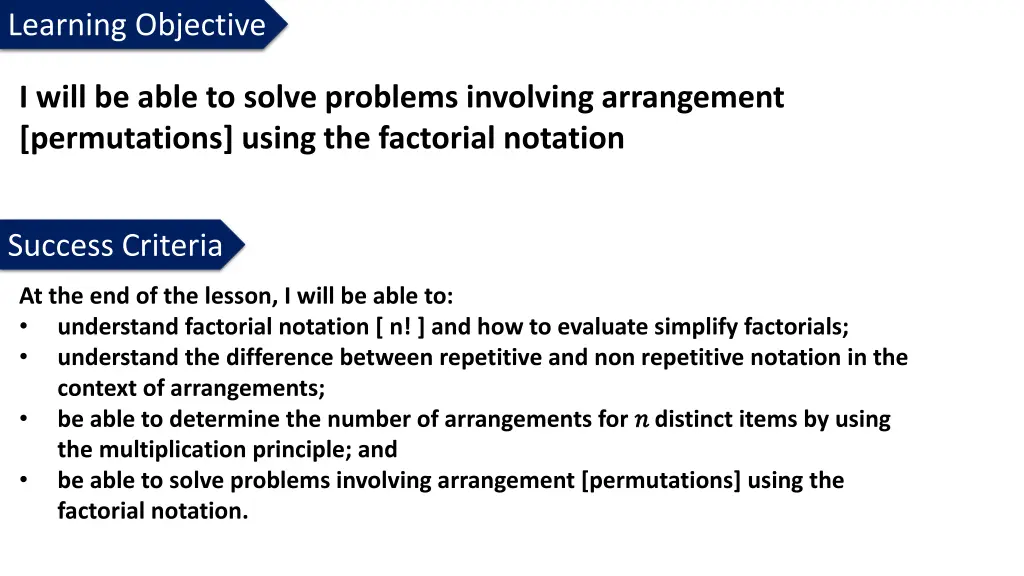
Permutations and Factorial Notation Explained with Examples
Learn about permutations and factorial notation in arrangements, understand factorial notation and how to evaluate it, differentiate between repetitive and non-repetitive arrangements, determine arrangements using the multiplication principle, and solve permutation problems with factorial notation. Explore examples of factorial notation, permutations, and repetitive arrangements to enhance your understanding.
Download Presentation

Please find below an Image/Link to download the presentation.
The content on the website is provided AS IS for your information and personal use only. It may not be sold, licensed, or shared on other websites without obtaining consent from the author. If you encounter any issues during the download, it is possible that the publisher has removed the file from their server.
You are allowed to download the files provided on this website for personal or commercial use, subject to the condition that they are used lawfully. All files are the property of their respective owners.
The content on the website is provided AS IS for your information and personal use only. It may not be sold, licensed, or shared on other websites without obtaining consent from the author.
E N D
Presentation Transcript
Learning Objective I will be able to solve problems involving arrangement [permutations] using the factorial notation Success Criteria At the end of the lesson, I will be able to: understand factorial notation [ n! ] and how to evaluate simplify factorials; understand the difference between repetitive and non repetitive notation in the context of arrangements; be able to determine the number of arrangements for ? ? distinct items by using the multiplication principle; and be able to solve problems involving arrangement [permutations] using the factorial notation.
Concept Development Factorial notation Factorial notation In general, for n 1, n! (n factorial) is the product of the first n positive integers ?! = ? ? 1 ? 2 ? 3 3 2 1 Example: 5! = 5 4 3 2 1 = 120 [5 factorial] Note: 0! = 1 ?! = ? ? 1 ! Example: 5! = 5 4!
Guided Practice Example 3! 8! 5! 8!3! 3! = 3 2 1 = 6 8! 5!=8 7 6 5 4 3 2 1 5 4 3 2 1 11! = 8 7 6 = 336 11! 8!3!=11 10 9 8! 8! 3 2 1=11 10 9 3 2 1= 165
ClassPad Factorial Notation 6! = 5! = 4! = 3! = 2! = 1! =
Concept Development Permutations Definition: The number of ways n objects can be arranged in a certain order. Consider the following situation: Justin has 5 books he wants to put on a shelf: Mathematics (M), Physics (P), English (E), Biology (B) and History (H). In how many ways can he do this? No. of ways for to order books Number of ways the books can be arranged: 5 4 3 2 1 = 5! = 60 1st 2nd 3rd 4th 5th 5 4 3 2 1
Guided Practice In how many different orders can the names of 6 candidates be listed on a ballot paper for a local council election? 6 5 4 3 2 1 = 6! = 720 How many different 3-digit numbers may be formed using only the digits 5, 7 and 9 where repeated digits are not permitted? 3 2 1 = 3! = 6
Concept Development Repetitive notation (index notation) If you have a bag of 4 balls numbered with one to 4, you draw ball from the bag, note the number, put it back. Repeat the process many times. In this case, every time you draw a ball, there are four possibilities. Hence the possible arrangements is 4nafter you draw nth times.
Guided Practice a) 5! = 5 4 3 2 1 = 120 No. of ways for each letter 1st 2nd 3rd 4th 5th 5 4 3 2 1 No. of ways for each letter b) 5 5 5 5 5 = 3125 1st 2nd 3rd 4th 5th 5 5 5 5 5
Guided Practice Mandy has to choose 4 optional subjects from a list of 12 for her college application. She has to write them in order of preference on her application form. How many different ways can Mandy complete the selection form? 1st 2nd 3rd 4th 12 11 10 9 = 11880 12 11 10 9
Concept Development Permutations For finding the number of PERMUTATIUONS of r items from n distinct items, the general rule is: ?! ? ? ! In permutations, order of the arrangement is IMPORTANT.
ClassPad ClassPad
Guided Practice Mandy has to choose 4 optional subjects from a list of 12 for her college application. She has to write them in order of preference on her application form. How many different ways can Mandy complete the selection form? 1st 2nd 3rd 4th 12?4 12! 12 4 ! = 11880 ???= 12 11 10 9 =
Guided Practice Find the number of different four digit numbers that can be formed from the digits 1 9, if each digit can only be used: a) only once b) More than once 9?4 ???= =9! 5! = 3024 9 9 9 9 = 94= 6561
Guided Practice Mark wants to set up his pin number (6 digits) for his credit card from the 0 to 9. He does not want to repeat any numbers. a) b) If he wants the first number to be 2, how many ways can he set up his pin number now? How many ways can he set up his pin numbers? 10?6= 151200 4th 5th 6th a) ???= 1st 2nd 3rd 1 9 8 7 6 5 OR 10 9 8 7 6 5 = 151200 9?5= 15120 1 ???=
Guided Practice How many different even four-digit numbers can be formed from the digits 1 8, if each digit may be used only once? 4th 1st 2nd 3rd 7 6 5 4 7 6 5 4 = 840
Guided Practice If no digit can be used more than once, find how many numbers that can be formed from the digits 3, 4, 5, 6, 7, 8 are: a) Two or three- digit numbers b) Six-digit numbers and even c) Greater than 7000 6th 4th 5th 1st 2nd 3rd a) ? = 6 3 1 5 4 3 2 2 digits: ? = 2 6?2= 30 3 digits: ? = 3 6?3= 120 6?2+ b) 5 4 3 2 1 3 = 360 4th 1st 2nd 3rd c) 4 digits: 5 4 3 2 6?3= 150 2 5 4 3 = 120 6?5= 720 6! = 720 5 digits: 6?5+ 6! = 1560 Total:120 +
Independent Practice Complete Ex 10B



